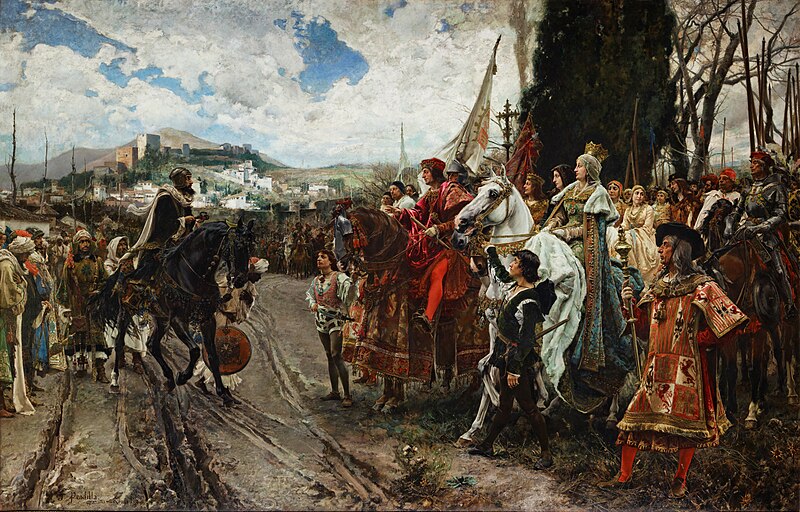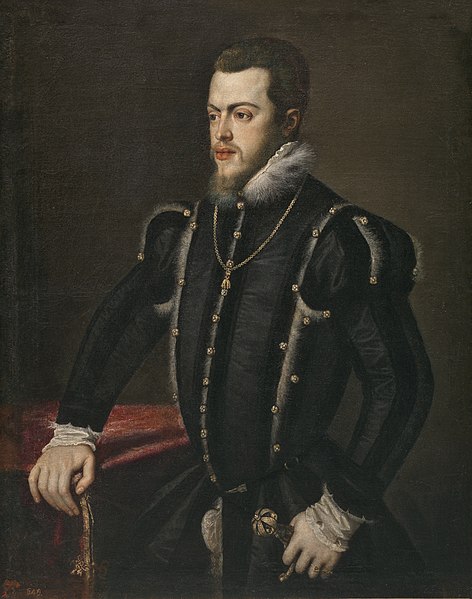5 The Baroque in Spain
The Baroque in Spain
Spain and the Time of Discovery
It is not possible to focus on modern western civilization without considering the Americas and what contributed to their development and growth. Because geography separates Spain and Portugal from the rest of Europe, their development in terms of politics and religion, in particular, was distinct and are often described separately from the rest of Europe, though we can see common threads. As you read, consider what is familiar and what is new. What, if anything, might you consider beautiful about what is described here? How is the movement of people and the impact on cultures and beliefs both beautiful and often difficult?
The Iberian Peninsula
A clear understanding of the Americas would be impossible without first looking at the Iberian Peninsula. The people, social customs, religious practices, laws, and cultural beliefs of the civilizations which formed on the American continent after the turn of the 16th century were based in European models. During the bicentennial of 1992 scholars suggested that the New World was not new, and that the Americas were not “discovered” at all but that “conquered” is a better word to describe the process. Rethinking the terminology that has been used to describe the merging of two dissimilar worlds. To complicate matters even more, most English-speaking children in the United States have been taught American history from an Anglo-centric point of view. Students were taught that the Spanish Inquisition was a vile and horrific period of history, though they rarely hear of Mary Tudor’s measures against Protestants in England, Elizabeth’s burning of dissenters, or the witch hunts of England or Germany. English history is carefully taught, while Spanish history is often ignored.
Geographic Isolation
Geography isolated Spaniards and Portuguese from the rest of Europe. The Pyrenees interrupted the flow of men and ideas between the Iberian Peninsula and the rest of Europe. On the other hand, Africa was only twelve miles away across the Strait of Gibraltar. This encouraged easy intercourse with the south, and the Iberian Peninsula became historically and socially an African outpost on European soil. The soil and climate of Spain and Portugal were very poor. Five rivers cut the land into sections and fostered regionalism. Mountain ranges also block rain-bearing clouds with the result that the central plateau is a windswept and treeless plain blistered in the summer and icy in the winter. The well- watered and temperate mountainous areas of the north and northeast offer only meager valleys for cultivation. The Mediterranean coast has good soil and a subtropical climate which produces olives, oranges, rice and sugar. The land is poor for the farmer and required sharing the water rights.

The Muslim Influence

In the year 711 Muslims from Africa conquered and occupied most of the peninsula. These people exerted a profound influence on cultural and economic life, and maintained their hold over a gradually reduced share of the region until their final defeat in 1492. Muslim rule was tolerant in comparison to the Christians throughout the rest of Europe as well as Spain once it was unified under Ferdinand and Isabella. The Christians who had fled to the northern mountains were invited to return, promised security of person and property, and assured full freedom of worship. The Muslims were content with the special but not exorbitant tax imposed upon Christians. Many Christians returned to their homes and lived peaceably with their Muslim neighbors; they were called Mozarabs, “Arabized folk.” However, many Muslims lived unmolested in Christian communities and were called Mudejares. The numerous Jews went about their business without interference. Re-conquest by Christian forces occurred between 1031 and the final expulsion in 1492.

Ferdinand and Isabella
In 1492 Ferdinand and Isabella, each powerful rulers in their own right, were united in marriage. It was from this point on that Spain became recognizable as a nation. Under the rule of these monarchs Spain entered what we call its “golden age.” They lessened the power of the nobles in order to consolidate royal rule. Commerce and industry increased. Pilgrims to the shrine of Santiago de Compostela brought new ideas and skills from France. The large ports of Seville, Valencia, and Barcelona attracted the trade of the Mediterranean world. The guilds increased their power as they were given the right to appoint members to the city councils or in some cases to influence decisions made by them. The church built great cathedrals, churches, and religious houses and gathered large endowments for their support. The clergy grew powerful and their privileges were increased. The church became a major landholder, and was an example in new farming techniques.
The Inquisition
The Inquisition was also established during this period. Religious tolerance which had been a unifying factor for centuries was eliminated. Muslims and Jews were told to leave Spain or convert to Catholicism. It is likely that Christopher Columbus shared the harbor with shiploads of Jewish immigrants who were being expelled from the newly Christianized areas. The Inquisition was determined to inquire after the personal morals and beliefs of individuals and to keep watch over these new converts.
Charles I
When Isabella died in 1504, her daughter Juana “the Mad” came to the throne. Her uncertain mental state made it necessary for her father, still king of Aragon, to act as regent of Castile. Juana’s husband died after only a year, and Ferdinand controlled the throne until 1516 when Juana’s son Charles was crowned Charles I of united Spain. He was then elected Charles V, Holy Roman Emperor. By the time he was 19 he was the nominal ruler, either through direct inheritance or through his imperial title, of much of Europe. In 1506, on his father’s death he inherited the Netherlands. In 1516, on Ferdinand’s death he inherited Spain, Naples, Sicily, and the Spanish colonies in the Americas. In 1519, on the death of Maximillian, he inherited Austria, and South Germany. Charles retained the throne until 1556 when he abdicated and gave his throne to his son, Philip II.
Philip II

Philip ruled for 42 years (1556-1598). Under his rule Spain found national unity and consolidated her hold upon the American empire. Philip was an admirer and example of Spanish virtues of personal dignity, sobriety, frugality in daily living, and religious devotion. He had a determination that justice should be done to the poor, a love of music and books, a capacity for unremitting toil. His acceptance of the principle of the divine right of kings was equated with the duty to do everything himself. All decisions, large and small, were made by Philip. There was a huge accumulation of paperwork, and a castle was set aside to house it. He read every dispatch from the remotest part of the kingdom. His officials called him the paper king. His determination to run the government on absolute bureaucratic lines required the construction of a royal palace where the nobility could be supervised. The greater nobility were expected to build houses and live in Madrid, the lesser nobles were to be housed by the people. Elaborate court ceremonies kept nobles busy leaving no time to plot against the king.
With the Muslims and Jews expelled from Spain, Philip concentrated on the new threat, the “Protestant infection.” Philip responded to the problem by intensifying the attack of the Inquisition against all who deviated from Catholic doctrine and by zealous spiritual reform within the church itself. The inquisitor general sought heresy among the Spanish nobility and the clergy. The discovery of Protestants set off waves of burning. All Spaniards were forbidden to study at foreign universities. Spanish Catholicism, in Philip’s mind, had to remain pure and unsullied by even the less pure faith of other Catholic countries.
Adapted from HUM 122 OER Textbook at OER Commons by Marc Nash is licensed CC BY 4.0.
